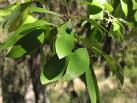Scrub bay Tree Information
Images of Scrub bay:






Scrub bay grows in the following 12 states and provinces:
Alabama, Delaware, Florida, Georgia, Hawaii, Louisiana, Maryland, Mississippi, North Carolina, South Carolina, Texas, VirginiaInformation about Scrub bay:
The Persea Borbonia is commonly known as the Redbay, Scrub-bay, Shorebay, Silkbay as well as Swampbay.
The currently accepted scientific name for redbay is Persea borbonia (L.) Spreng. (Lauraceae). Morphological variety complicates redbay taxonomy. Three varieties, also regarded as separate species, are distinguished based on habitat differences and the morphology of the hair on the undersides of the leaves: P. b. var. borbonia - typical variety P. b. var. humilis (Nash) Kopp - commonly known as silkbay; distinguished from the typical variety by especially dense hair ; restricted to the oak (Quercus spp.)-pine (Pinus spp.) scrub of peninsular Florida . P. b. var. pubescens (Pursh) Little - commonly known as swampbay; distinguished from the type by crooked hair and an affinity for swampy areas . This review follows Little and Kartesz and Kartesz who favor three varieties. There are no recognized subspecies or forms.Redbay grows on the Atlantic and Gulf coastal plains and in peninsular Florida. Its range extends from southern Deleware to southern Texas. It also grows in the Bahamas . It is cultivated in Hawaii .Redbay is common in pocosins , forested wetlands , mixed hardwood swamps , and Mississippi pitcher-plant (Sarrecenia spp.) bogs . In the drier Big Thicket area of eastern Texas, it sometimes grows on upland longleaf pine (Pinus palustris) savannas and poorly drained sites where mesic vegetation form localized patches in a more xeric landscape . Redbay is a principal associate in the Okefenokee Swamp , a dominant in Cumberland Island understories , and common in the Great Dismal Swamp and Big Cypress Swamp . Red bay dominates many everglades tree islands and cypress dome understories. It is occasional in the understories of high hammocks but a major component in low hammocks. When seen from the air, southern Florida low hammocks have a characteristic redbay-dominated tail which extends downstream in the direction of the everglade's flow . Some southern Florida tree islands are so dominated by redbay, sweetbay (Magnolia virginiana), and loblolly-bay (Gordonia lasianthus) that they are known as "bayheads" . Overstory associates include red maple (Acer rubrum) , cabbage palmetto (Sabel palmetto) , spruce pine (Pinus glabra) , slash pine (P. elliottii) , loblolly pine (P. taeda) , sand pine (P. clausa) , southern redcedar (Juniperus silicicola), loblolly-bay, cassena (Ilex cassine), titi (Cyrilla racemiflora) , sweetbay, and Atlantic white-cedar (Chamaecyparis thyoides) . Understory associates include hurrahbush (Lyonia lucida), swamp fetterbush (Leucothoe racemosa), sweetspire (Itea virginica), poor-man's soap (Clethra alnifolia), coral greenbriar (Smilax Walteri), and wax myrtle (Myrica cerifera) . Wells cited redbay as a dominant in his classification system of Coastal Plain community types.Some of the information provided here is attributed to:Van Deelen, Timothy R. 1991. Persea borbonia. In: Fire Effects Information System, [Online]. U.S. Department of Agriculture, Forest Service, Rocky Mountain Research Station, Fire Sciences Laboratory (Producer). , available at the USDA Fire Effects Information System (FEIS) website